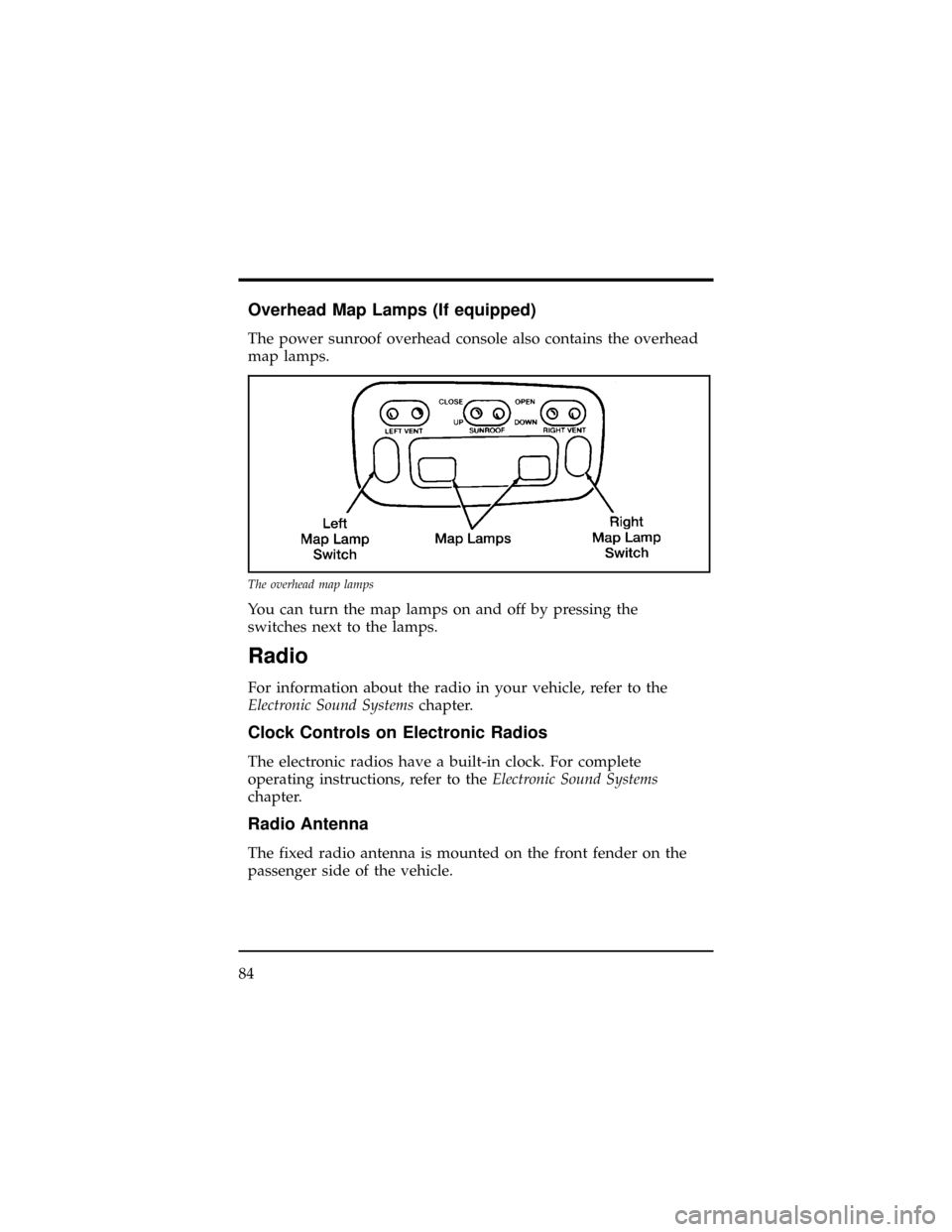radio controls Mercury Villager 1998 Owner's Manuals
[x] Cancel search | Manufacturer: MERCURY, Model Year: 1998, Model line: Villager, Model: Mercury Villager 1998Pages: 400, PDF Size: 2.06 MB
Page 37 of 400

Radio Controls
How to turn the radio on and off
Press the ªVOL-PUSH ONº knob or the ªAM/FMº button to
turn on the radio. Press the ªVOL-PUSH ONº knob again to turn
it off.
How to adjust the volume
Turn the ªVOL-PUSH ONº knob to increase/decrease volume.
Bars illuminate in the display to show the relative volume level.
NOTE: If the volume level is set above a certain listening
level when the ignition switch is turned off, when the
ignition switch is turned back ON, the volume will
come back to a ªnominalº listening level. However, if
the radio power is turned off, the volume will remain in
the position it was set at when radio power is
switched back on.
Selecting the AM or FM frequency band
Push the ªAM/FMº button to select the desired frequency band.
When in the radio mode, pushing the button more than once
will alternate between AM, FM1 and FM2. These functions are used
with the station memory buttons described underHow to tune
radio stations.
How to tune radio stations
There are four ways for you to tune in to a particular station on
the radio. You can manually locate the station by using the
ªTUNEº function, ªSEEKº to the station, ªSCANº to the station
or select the station by using the memory buttons, which you
can set to any desired frequency.
mUsing the ªTUNEº button to select the tune function
Electronic Sound Systems
33
Page 46 of 400

NOTE: In some instances, the radio may have CD changer
controls, even if there is no CD changer.
The digital display on the radio shows the disc and track
number. Indicators for compression on (ªCOMPº) and shuffle on
(ªSHUFFLEº) are also in the display. These features are
described in more detail later in this chapter.
Once a magazine is inserted, operation of the CD changer will
override that of the cassette player or radio.
NOTE: The volume, bass, treble, balance, and fader controls on
the radio are also used with the CD changer.
Slide the CD door all the way to the right. Insert the magazine
into the magazine opening. If a magazine is already loaded,
pressing ªCDº will start CD play. For the first three seconds
after a disc starts playing, the radio display shows the disc number
(CD-01 for disc 1). From seconds four through six, the track
number is shown (TR-02 for track 2). For the remainder of the
track, the display shows the disc and track number (01-02 for disc
1, track 2).
When the disc reaches the end, the disc changer automatically
goes to the beginning of the next disc and resumes playing.
How to eject the CD magazine
Press the eject button on the lower left of the CD changer to eject
the magazine whether or not the audio system is on.
NOTE: If the ignition key is turned OFF during play and then
is set to the ON or ACCESSORY position, the CD
changer will resume playing in the mode (radio/tape/CD)
it was in when ignition was turned off.
42
Page 51 of 400

Rear Seat Radio Control Operation
How to turn the rear seat radio controls on and off
Press memory preset buttons ª3º and ª5º simultaneously on the
face of your radio to turn the rear seat radio controls on. A
headphones symbol (
) will appear in the display when the
rear seat controls are on. Press ª3º and ª5º simultaneously again
to turn rear seat radio controls off.
How to adjust the volume
Press the right (+) side of the ªVOLUMEº rocker switch to
increase volume, and push the left (±) side to decrease the volume
of the rear speakers.
NOTE: Rear seat control volume can be set no higher than
current radio setting.
Rear seat radio controls (if equipped)
Electronic Sound Systems
47
Page 52 of 400

Using the ªPROGRAM ADVANCEº button
This button has different functions depending on the audio
source. In radio mode, pressing this button will cycle through the
memory presets for the given frequency band (AM, FM1,
FM2). In the cassette mode, pressing this button will change tape
sides. During the CD operation, this button will cycle through
the discs (one button push, one disc advance).
Using the ªSOURCE SELECTº button
This button will cycle through all modes. The cycle order is as
follows: AM, FM1, FM2, tape, CD (if equipped).
How to turn the speakers on and off
When the rear seat controls are on, push the ªSPKRS, ON-OFFº
button to turn all speakers off. Push again to turn all
speakers on.
Using headphones with the rear seat controls
Two 3.5 mm headphone jacks have been provided on the rear
seat controls. Plug headphones into the provided jack(s) to operate
headphones. Note that the headphones can be used only when
the speakers are off.
Using the ªSEEKº button
This button has different functions for each source (mode). In
radio mode, pressing ªSEEKº proceeds to the previous or next
station. In cassette mode, this button is an Automatic Music Search
(AMS), moving to the next or previous selection on the tape. In
CD mode, this button moves to the beginning of the next or
previous track.
48
Page 53 of 400

How to Use Your Steering Wheel Audio
Controls (If equipped)
If your vehicle is equipped with steering wheel audio controls,
the controls are located on the inner right rim of the steering wheel.
These controls duplicate some of the audio functions.
How to adjust volume
Press the up arrow button () to increase the volume.
Press the down arrow button (
) to decrease the volume.
Using the ªNEXTº button
This control has different functions for each source (mode). In the
radio mode, the radio will cycle through the memory presets
for the given frequency band. In cassette mode, the tape advances
to the next selection. In CD mode, the CD will move to the
next track on the given disc.
Common Radio Reception Conditions
Several conditions affect FM reception and can result in noise or
interference in the reception. These are:
Distance/Strength
The strength of the FM signal is directly related to the distance
the signal must travel. The listenable range of an average FM signal
is approximately 25 miles (40 km). Beyond this distance, the
radio is operating in a ªfringeº area and the signal becomes weaker.
Terrain
The terrain (hills, mountains, tall buildings) of the area over
which the signal travels may prevent the FM signal from being
noise-free.
Electronic Sound Systems
49
Page 60 of 400

The controls for the climate control systems, headlamps, clock,
radio, rear window washer and wiper, hazard flasher, power mirror
controls, and speed control are all on the instrument panel.
Climate Control Systems
Function Selector Buttons
There are six function selector buttons: OFF, Mix, Defrost, Panel,
Panel/Floor, and Floor. When you press a function selector
button, the indicator light on the button will illuminate. If your
vehicle is equipped with a rear passenger compartment climate
control system, the instrument panel will also include a rear
seat function selector.
mThe OFF button shuts off the air supply to all outlets and
stops all fan operations. Use this setting when driving through
an area where outside air is unpleasant or dusty.
Climate control system panel
56
Page 71 of 400

NOTE: For maximum heating and cooling for front seat
passengers, set the rear fan switch to the OFF position.
Automatic Temperature Control System
The control for your Automatic Temperature Control (ATC) is
located at the center of the instrument panel above the radio. The
ATC operates only when the ignition key is turned to the ON
position and the engine is running.
To turn the ATC on, push the AUTOMATIC button or any of the
five airflow function selector buttons:
,,,,
or
.
To turn the ATC off, press the OFF button.
To change the temperature in the display window, select any
temperature between 65É F (18É C) and 85É F (29É C) using
the
TEMPbutton.
Rear seat climate control system panel
Controls and Features
67
Page 88 of 400

Overhead Map Lamps (If equipped)
The power sunroof overhead console also contains the overhead
map lamps.
You can turn the map lamps on and off by pressing the
switches next to the lamps.
Radio
For information about the radio in your vehicle, refer to the
Electronic Sound Systemschapter.
Clock Controls on Electronic Radios
The electronic radios have a built-in clock. For complete
operating instructions, refer to theElectronic Sound Systems
chapter.
Radio Antenna
The fixed radio antenna is mounted on the front fender on the
passenger side of the vehicle.
The overhead map lamps
84
Page 89 of 400

Coin Tray
The slide-out coin tray is located in the instrument panel for your
convenience. It is located below the radio controls.
Coin tray
Controls and Features
85
Page 132 of 400

Rear Seat Cupholders (available on some models)
Your vehicle may have the following types of cupholders:
mtwo second row cupholders attached to the captain seats (if
equipped)
mtwo third row cupholders on the left side and one cupholder
on the right side (if equipped)
mone cupholder built into the side trim panel (without rear
radio controls)
WARNING
Objects stored on the ledges below the rear side windows
can become dangerous projectiles during a sudden stop
or collision. Put small objects only in the storage
compartments.
Third Row Seat Storage Compartment (If equipped)
Your vehicle may come equipped with a folding cupholder/storage
tray/storage compartment built into the passenger's side of the
third row seat. Find the indented ledge on the right of the
cupholder and pull it up to reveal the storage compartment.
Power Point Electrical Outlet (If equipped)
Your vehicle may be equipped with a 12 volt power point outlet
located just below the rear seat audio controls. The power
point can be used in place of the cigarette lighter for optional
electrical accessories.
NOTE: Do not plug the cigarette lighter into this power point
electrical outlet. Use the cigarette lighter.
128